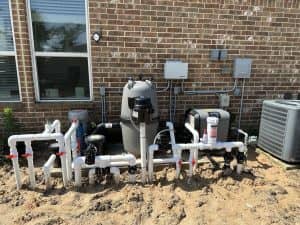Pool Chemistry Basics: Simple Guide to pH, Chlorine & Shocking
If you’re a new pool owner, understanding pool chemistry basics can feel like learning a new language — but it doesn’t have to be complicated. Mastering the essentials like pH, chlorine levels, and when to shock your pool will keep your water crystal clear, safe to swim in, and easy to maintain.
At Limitless Custom Pools and Backyards, we build high-performance pools and help you care for them every step of the way. Let’s break down the core components of pool chemistry in simple terms.
🌡️ pH Balance: The Starting Point for Pool Chemistry
Your pool’s pH level measures how acidic or basic the water is — and it affects everything from swimmer comfort to the lifespan of your equipment.
-
Ideal pH Range: 7.2 to 7.6
-
Low pH (Too Acidic): Can corrode metal, damage plaster, and irritate skin and eyes.
-
High pH (Too Basic): Causes cloudy water, scaling, and reduces chlorine effectiveness.
💡 Maintaining the correct pH is the foundation of all pool chemistry basics. Use pH increasers or reducers as needed and test weekly.
🧼 Chlorine: The Primary Sanitizer
Chlorine kills bacteria, algae, and viruses — making it one of the most critical parts of any pool chemistry routine.
-
Ideal Chlorine Range: 1.0 to 3.0 ppm
-
Stabilizer (CYA): Helps chlorine last longer in sunlight — ideal level is 30–50 ppm.
-
Forms of Chlorine: Tablets, liquid, granular
💡 Keep chlorine levels consistent for safe swimming. Automated feeders or salt systems can simplify this part of your pool chemistry plan.
⚡ Shocking Your Pool: The Weekly Reset
Part of basic pool chemistry is knowing when and how to shock your pool — which means adding a large dose of chlorine to destroy chloramines and clear up contaminants.
When to Shock Your Pool:
-
Once a week during summer
-
After heavy use (parties, storms, etc.)
-
If the water smells strongly of chlorine (a sign of chloramines)
💡 Shock at night for best results, and don’t swim until chlorine returns to safe levels (under 5 ppm).
🧪 Weekly Pool Chemistry Checklist
Here’s a simple schedule to stay on top of your pool chemistry:
-
Test pH, chlorine, and alkalinity
-
Adjust levels as needed
-
Shock weekly or as needed
-
Brush & circulate the water after treatment
💡 Use a reliable test kit or strips and log your results to track trends.
🛠️ Want to Make Pool Chemistry Even Easier?
Limitless Custom Pools offers smart upgrades like:
-
Saltwater systems
-
Automatic chlorinators
-
App-controlled automation for testing and treatment
These tools help you stay in control of your pool chemistry with less manual work.
Final Thoughts on Pool Chemistry Basics
Keeping your pool safe and sparkling doesn’t require a science degree. With just a few minutes each week, you can master the pool chemistry basics and enjoy more time in the water.
📞 Need help or want to upgrade your pool system? Contact Limitless Custom Pools today for expert advice and professional service.B


